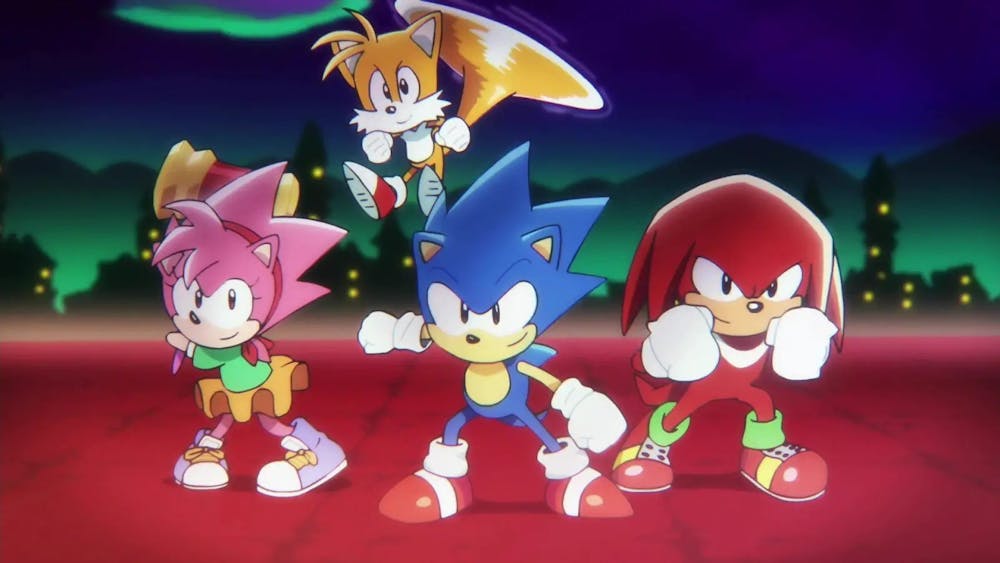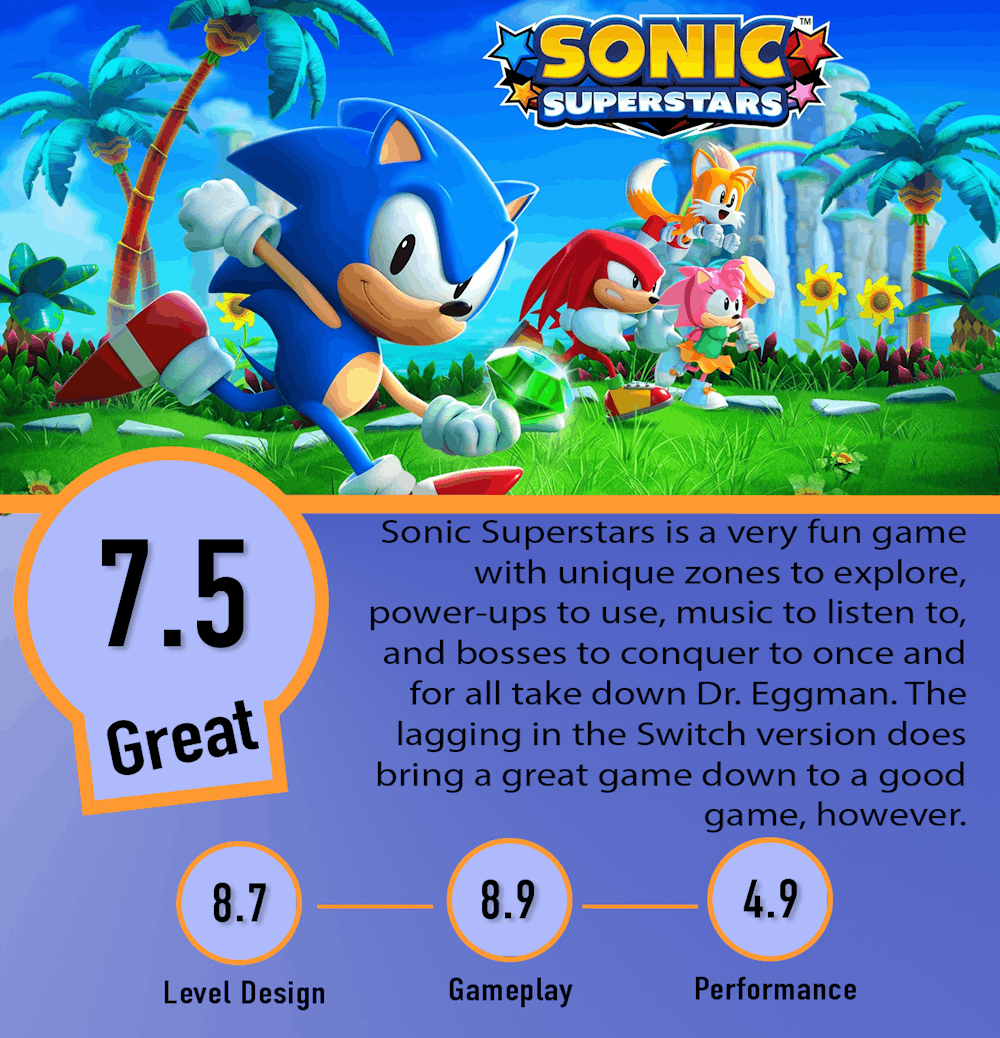The opinions and views expressed in this article are those of the author and do not reflect the opinion of Byte or Byte's editorial board.
Reviewed on: Nintendo Switch.
The franchise Sonic the Hedgehog, created by Sega, was one of my first forays into the world of video games. I vividly remember for Christmas receiving the Xbox 360 version of Sonic Ultimate Genesis Classic Collection, which had Sonic 3D Blast and Sonic Spinball as well as Sonic 1, 2, 3, and Knuckles. I spent countless hours with these games despite the fact that I could barely beat the second zone of each game or, in the case of Sonic 3 and Knuckles, the first one (I didn't realize all you had to do for the airship chase sequence in Angel Island Zone was to keep your hands on the right button. I know, clever of me). Ever since, I have gravitated to pretty much every Sonic game that has come out, no matter how good the game looked or what people online had to say about it. That being said, I've experienced my ups and downs with this franchise. So, when Sonic Superstars, a return to classic Sonic gameplay, was announced, I was ecstatic. I pre-ordered it digitally and played it right when it came out. How does it fare, though, with the rest of Sonic's lineage of games? Well, let me tell you.
Blue-Blurring Level Design
Like every other Sonic game, you have many zones, most of which consist of two acts. Some late-game zones only have one. Each zone is also widely different from one another, and I really like the different environments of each. You start off with a Green-Hill-esque Bridge Island Zone, which acts as your traditional tropical environment set among blue oceans and green hills. The zones get even more diverse in location as the game progresses. For example, you have Speed Jungle, a zone shrouded in shrubbery deep in a tropical forest. You have acts like Sky Temple Zone, which has you traverse from the bottom of an area surrounded by ruined temples up into the sky where the sanctuary is. You have zones that resemble familiar areas in other Sonic games, like the Pinball Carnival Zone acting as a Halloween-esque amusement-based level like Casino Night Zone. Lagoon City Zone, which is the water level game, reminded me a lot of Hydrocity Zone with its fast-paced slope sections. Hydrocity happens to be one of my favorite water levels up to this day, so this was very much a good thing.

Sand Sanctuary Zone reminded me a lot of the scrapped level Desert Dazzle Zone, which was initially supposed to be in Sonic CD. Press Factory Zone was that of a typical late-game, Eggman-powered machine factory full of deadly traps like crushers, etc. My favorite level in the game was Golden Capital Zone, which was what I assume to be the lava level. Honestly, being a sucker for levels with lava in them is why this level is one of my favorite in the game, along with the location of the level being that of a regal capital building and bank hybrid. I also liked the technologically sound environment of the Cyber Station Zone. The Frozen Base Zone is that of an underground frozen stronghold, which was a good ice level, and the Egg Fortress Zone, which, like the last zones in almost every Sonic game, is Eggman's fortress in outer space. I think the difficulty curve is good for a Sonic game, and I love how expansive each level is, leaving room for lots of exploration to look for ring portals that will lead to chaos emeralds, easter eggs, and alternate paths with different platforming sections, among many more. Playing these zones made me feel nostalgia for older titles.
Gameplay Out the Gear Ratio
There are many different gimmicks in each zone that make each level fun to play. Speed Jungle introduces the use of harpoon launchers to reach higher ground, grinding on rails, swinging across gaps on vines, and using pully levers in the form of roots, as well as getting past a completely dark section. In the Sky Temple Zone, you must rely on the use of the air currents to push Sonic through certain areas of the zone. There are also lots of platform block puzzles you must master. I know many people hate the puzzle sections in Sonic games because you must wait for things to happen, which beats the purpose of Sonic. In similar fashion, Pinball Carnival allows you to bounce Sonic along an environment filled with pinball elements, including bounce pads and flippers. There’s a point in the level where you have to alternate between coasters to get to higher platforms above gaps. Lagoon City features a section where falling food comes for you, and you’re pushed forward by currents in a water section littered with mines. In the Sand Sanctuary Zone, there is a part where you must utilize the back of a giant snake to get past gaps as well as use sand geysers to rise up to get from platform to platform before the geysers come down., which is interesting. Golden Capital Zone has up-and-down moving blocks across lava pits and alternating left-and-up moving blocks, as well as cylinders that spin Sonic a certain way, depending on when he jumps out.

Finally, the Cyber Space zone allows Sonic to turn into a mouse to ride electrical cables. There are many other tiny gimmicks not mentioned that make each zone feel fun to play. Speed is a significant part of the game. Speeding down corkscrews and loops, as well as running sideways upon walls to save flickies from different badniks and complete zones to reach Eggman, while collecting chaos emeralds is the basis of any Sonic game. You then have the bosses, who have more depth to them than in the previous entry, making the battles seem more fun and less tiresome. The exception is a late-game encounter with returning villain Fang, where you fly above lava, avoiding traps on a small block while chasing him down. This boss takes around three minutes without making mistakes. Going back to the chaos emeralds, not only does getting all seven allow Sonic to turn into his super form, but he can gain different abilities that act sort of like Wisps in Sonic Colors, where he can drill, float, and shoot bullets, among other things. I did feel that the special stages to obtain these were a little too simple and boring, though. While I've been talking mainly about the main story up to this point, you also have modes such as Time Attack and different battle modes. I have yet to dig deep into these game modes, but Battle Mode looks extremely fun to play. Zap Scrap, where you attack your opponents with projectiles to decrease their damage, seems chaotic, and Survival, where you try to get to the end of the stage while avoiding cannonballs that break off some of the stage you’re playing through, seems nerve-wracking but a good time with friends. Star Snatcher, where getting hit by enemies can make you lose the stars you collect and whoever has the most wins, reminds me of a Battle Mode from one of the Super Mario games. Seeing this mode brought me nostalgia and a smile on my face. I can’t wait to play a little of the battle modes. The last thing I would like to mention is that this whole game can be played in four-player multiplayer, which is the first for the series. This new feature for the Sonic series allows people to play couch multiplayer with friends, playing up to four different playable characters, all with unique abilities such as a double jump for Amy, glide for Knuckles, and flying for Tails, etc.
Pitstop Presentation and Performance
Presentation-wise, the game looks good. It has a 2.5D art style, and the cutscenes are animated beautifully by the same creators who made them in Sonic Mania. The heads-up displays of the menus are decent enough for what it is: easily accessible and simple to navigate. The game's color, according to some people online, is dull for the series, like Digital Trend calling the colors flat. But I'm not that picky, and, like most other people, I think the colorful visuals of the game make the environments stand out as some of the most visually stunning in any Sonic game. Also, the music presented in the game livens the environment of the zones and gets you ready to start the adventure when you're just on the title screen and menu. I really enjoy the Super Sonic theme in this game, with it possibly being my favorite ever. The music does alternate a lot between Jun Senoue tracks (similar to the ones he made in Sonic the Hedgehog 4 and his midis in Mania) and the tracks by Tee Lopes, which is a little disorientating hearing how stylistically different they are. Since I was playing on a Nintendo Switch, I did notice some severe lagging in some parts of the game. Now, the lagging wasn't all too consistent, luckily; it happened mainly when too much stuff was on the screen or when loading up zones, but it did slow the pace of the game, which was disappointing.
Blurring Down the Finish Line
All in all, I really enjoyed this game for what it was worth. It wasn't quite up to par with Sonic Mania, and despite the expected lagging on the Nintendo Switch port, I had an enjoyable experience casually playing through each zone, meeting the new characters, and fighting the bosses. I feel you can easily get your $60 worth out of this game. It’s decently long, has lots of extra modes, and the main mode is really fun to replay. I can't wait for the next Sonic game, regardless of what it might end up becoming.

Sources:
SonicTheHedgehog, Sega, SonicFandom, SonicRetro, SonicRetro, SonicFandom, SonicFandom, SonicFandom, SonicFandom, SonicRetro, SonicSuperstars, SonicTheHedgehog, SonicFandom, DigitalTrends, SegaRetro, SonicFandom, TeeLopesMusic
Photos:
Nintendo, EpicGames, GamingTrend
Contact Cameron Tyo with comments at cttyo@bsu.edu



















